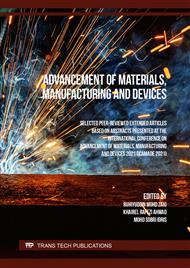[1]
G. Dai et al., Direct and indirect measurement of large electrocaloric effect in barium strontium titanate ceramics,, Int. J. Appl. Ceram. Technol., vol. 17, no. 3, p.1354–1361, (2020).
DOI: 10.1111/ijac.13384
Google Scholar
[2]
A. Elbasset, S. Sayouri, F. Abdi, T. Lamcharfi, and L. Mrharrab, Effect of Sr addition on piezoelectric properties and the transition temperature of BaTiO3,, Glas. Phys. Chem., vol. 43, no. 1, p.91–97, (2017).
DOI: 10.1134/s1087659617010059
Google Scholar
[3]
L. Zhou, P. M. Vilarinho, and J. L. Baptista, Dependence of the Structural and Dielectric Properties of Ba1-xSrxTiO3 Ceramic Solid Solutions on Raw Material Processing,, J. Eur. Ceram. Soc., vol. 19, no. 11, p.2015–2020, (1999).
DOI: 10.1016/s0955-2219(99)00010-2
Google Scholar
[4]
Y. Luo, X. Liu, X. Li, and G. Liu, PTCR effect in BaBiO3 -doped BaTiO3 ceramics,, vol. 177, no. 3, p.1543–1546, (2006).
DOI: 10.1016/j.ssi.2006.07.020
Google Scholar
[5]
B. Huybrechts, K. Ishizaki, and M. Takata, The positive temperature coefficient of resistivity in barium titanate,, J. Mater. Sci., vol. 30, no. 10, p.2463–2474, (1995).
DOI: 10.1007/bf00362121
Google Scholar
[6]
Z. Zhou, Z. Tang, Z. Zhang, and W. Wlodarski, Perovskite oxide of PTCR ceramics as chemical sensors,, Sensors and Actuators, vol. 77, p.22–26, (2001).
DOI: 10.1016/s0925-4005(01)00667-0
Google Scholar
[7]
M. Guo, N. Masó, Y. Liu, and A. R. West, Electrical Properties and Oxygen Stoichiometry of Ba1-xSrxTiO3-δ Ceramics,, Inorg. Chem., vol. 57, no. 1, p.64–71, (2018).
Google Scholar
[8]
D. Sinclair, Characterization of Electro-materials using ac Impedance Spectroscopy,, Boletín la Soc. Española Cerámica y Vidr., vol. 34, no. 2, p.55–65, (1995).
Google Scholar
[9]
K. N. D. Ku Muhsen, R. A. Maulat Osman, and M. S. Idris, Giant anomalous dielectric behaviour of BaSnO3 at high temperature,, J. Mater. Sci. Mater. Electron., vol. 0, no. 0, p.0, (2019).
DOI: 10.1007/s10854-019-01065-x
Google Scholar
[10]
A. J. Moulson and J. M. Herbert, Electroceramics : Materials, Properties, Applications, vol. 9. (2003).
Google Scholar
[11]
J. Krupka, Frequency domain complex permittivity measurements at microwave frequencies,, Meas. Sci. Technol., vol. 17, no. 6, (2006).
DOI: 10.1088/0957-0233/17/6/r01
Google Scholar
[12]
N. Pour Aryan, Design and Modeling of Inductors, Capacitors and Coplanar Waveguides at Tens of GHz Frequencies,, (2015).
DOI: 10.1007/978-3-319-10187-3
Google Scholar



